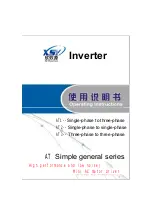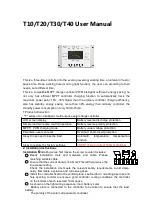
Page 46
Large-scale Decoder & Sound Decoder MX695/6/7/9
MENU SOUND Incr.Prog
.
CV 266 CV 267 CV 268
((((( + Total Chuff Part -
volume beat volume
(((( - steam
+ 2 - 40 + 3
(((( 0
= 43 = 17 = 255
7.2
“Incremental Programming” of sound CV’s,
an alternative to “normal” programming
Configuration variables (CV’s) for optimizing sound effects can of course be programmed in
the conventional manner by changing CV values using the cab in service mode (on the pro-
gramming track) or in operations mode (on the main track), but many can alternatively also be
programmed by
“Incremental” programming.
This method is not suitable for CVs where individual bits need to be set independently.
The “incremental programming” is a special process of the “operations mode” programming
with the following fundamental principle: the CV’s are not programmed with an absolute value
(as is normally the case) but rather the current value of a CV is being incremented or decre-
mented by a fixed value (defined in the decoder for each CV).
The function keys of the cab temporarily serve as instruments for the incremental program-
ming, which means they cannot be used for function output actuations during that time. The
function keys are temporarily assigned for this task with the “Pseudo-Programming”
CV #301 = 66
,
which changes the function keys to INC and DEC keys, first for CV #266 (that is the CV num-
ber derived from the value + 200).
Several CV’s are grouped together in one procedure for an easier and better handling. In the
case of CV #301 = 66, not only the leading CV #266 (“Lead-CV”) is assigned for incremental
programming but also CV #267 and #268.
This is again shown here by means of the ZIMO cab with the special MX31 display, but is val-
id analogous for the function keys of other cabs.
The function keys have the following special meaning
during the selection
procedure!
Incrementing!
Decrementing!
Set to default value!
Drawing of an MX31 display, not a photo!
The last line shown in gray (absolute CV values) will not be available until bidirectional communication is being implemented!
F0, F3, F6
Incrementing, decrementing and default setting of the lead CV number that was
entered during the “Pseudo-Programming” initiation CV #301 = … (or via menu
with the MX31).
F1, F4, F7
Incrementing, decrementing and default setting of the second CV number of that
group; which CV’s that are part of a group is shown in the CV table or is
indicated in the ZIMO MX31 cab display.
F2, F5, F8
Incrementing, decrementing and default setting of the third CV number of that
group (if the group includes 3 CV’s).
The incrementing and decrementing of CV values (usually in the 0…255 range) takes place in
steps of 1, 5, 10 or 15; this is predefined by the decoder software and cannot be changed. In-
termediate values can be entered by direct CV programming, which in reality is hardly neces-
sary.
The
“cuckoo jingle”
sounds when….
…. the upper or lower end of a CV value range is reached!
If RailCom is not available (because the system used is not equipped with RailCom), the value
of a particular CV can only be determined by reading it out on the programming track.
Alt-
hough, most of the time this is not necessary since the reaction to a changed CV value can
immediately be heard by the changing sound.
Note: With the MXDECUP update module it is possible to read-out and write complete CV and
parameter sets and if necessary edit them on a computer!
7.3
The test-run for
determining the motor’s basic load
The following procedure enables the (subsequent) adjustment of driving sound to engine load
(i.e. inclines, pulling weight
…), such as steam chuffs (volume and sound) with the CV’s #275,
276…
Technical background:
The load dependent sound is based on EMF (Electro Motive Force) measurements inside the decoder,
which is primarily used for keeping the motor speed constant during load changes. Before the decoder can
produce the correct sound for the respective driving conditions it has to know first what these measurements
are at normal “no-load” cruising speed (smooth rolling of the engine or train on straight level track). This
“basic load” of an engine or train is often considerably higher on model trains than on the real railroad, which
is due to gearbox losses, power pick-
ups etc. Deviations from this “basic load” will then be interpreted as in-
clines or declines, which triggers appropriately modified chuff sounds.
Initiated with “Pseudo-Programming”
CV #302 = 75
an
automated test run is performed to record the “basic load” factor in forward direction;
ATTENTION: the engine (or train) is
driven automatically
in forward direction for which un-
occupied track must be available of
at least 5 meters (15 feet),
with absolutely no inclines or
declines and without any (tight) curves.
With
CV #302 = 76
an automated recording run can be performed in reverse direction, for locomotives that have
different “basic loads” in this direction (otherwise, the basic load in reverse is considered iden-
tical to forward).
The measured results are stored in
CV’s #777 and 778
(slow/fast PWM values, forward) and
#779 and 780
(PWM values
in reverse direction); these CV’s can be read out and used as
needed for other vehicles, or used as base for further tests.
Note: A “heavy” train (a train with higher rolling resistance due to power pickups of lighted
coaches for example) ma
y have a different “basic load” than an engine with nothing on the
hook. A separate recording run may be required for such situation in order to obtain the best
load dependent sound.
ZIMO cab key arrangement:
(((((
1
F0
(((((
2
F1
(((((
3
F2
(((((
4
F3
(((((
5
F4
(((((
6
F5
(((((
7
F6
(((((
8
F7
(((((
9
F8
Summary of Contents for MX695
Page 6: ...Page 6 Large scale Decoder Sound Decoder MX695 6 7 9 ...
Page 7: ...Large scale Decoder Sound Decoder MX695 MX696 MX697 MX699 Page 7 MX697 ...
Page 8: ...Page 8 Large scale Decoder Sound Decoder MX695 6 7 9 ...
Page 14: ...Page 14 Large scale Decoder Sound Decoder MX695 6 7 9 ...
Page 15: ...Large scale Decoder Sound Decoder MX695 MX696 MX697 MX699 Page 15 ...
















































